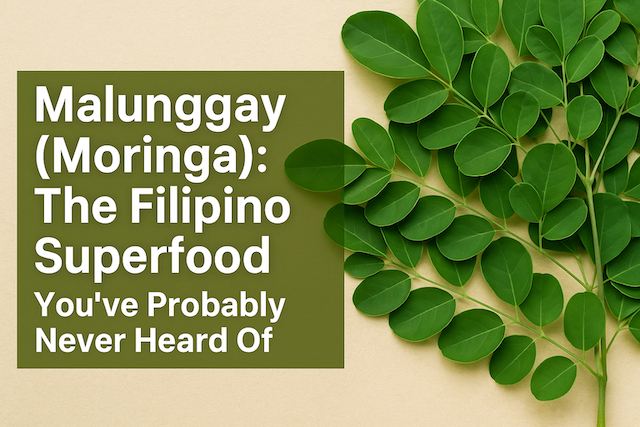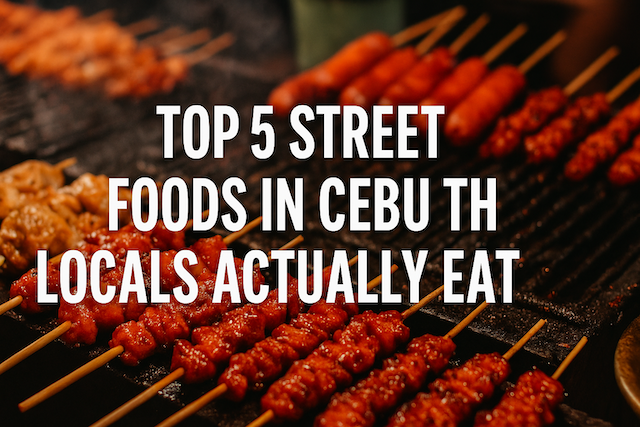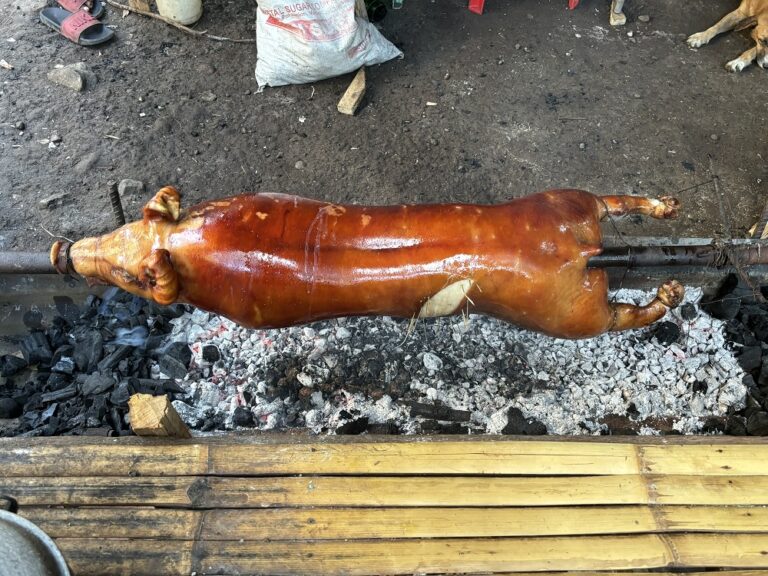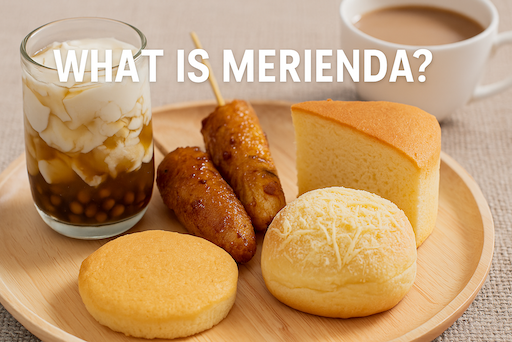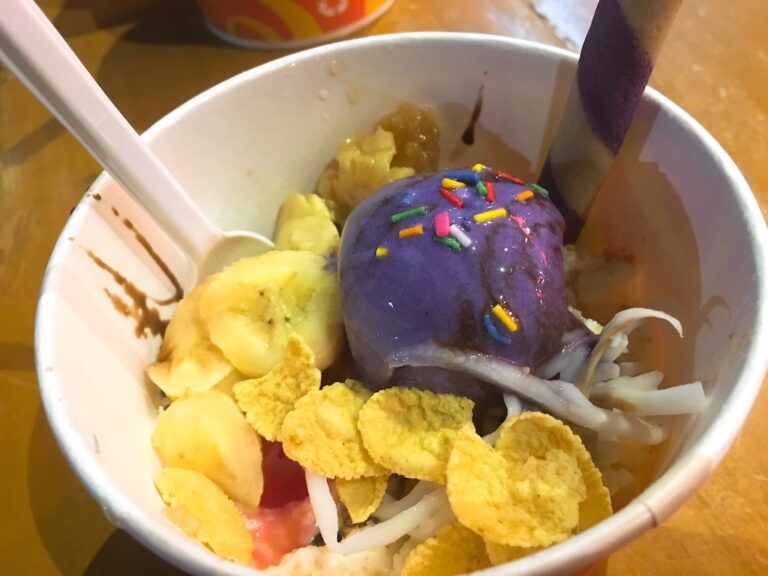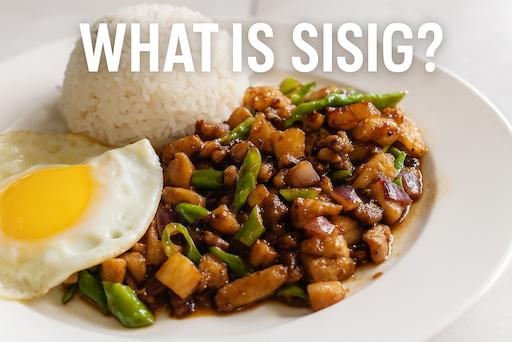Malunggay (Moringa): The Filipino Superfood You’ve Probably Never Heard Of
Contents
- 1 🌿 Malunggay (Moringa): The Filipino Superfood You’ve Probably Never Heard Of
- 1.1 1. Introduction – A Superfood Hiding in Plain Sight
- 1.2 2. What Is Malunggay? (Moringa 101)
- 1.3 3. Nutritional Power: Why It’s Called the “Miracle Tree”
- 1.4 4. How Filipinos Use Malunggay in Everyday Life
- 1.5 5. Where to Find Malunggay in Cebu
- 1.6 6. Malunggay vs. Aojiru (Japanese Green Juice): A Cultural Contrast
- 1.7 7. Health Benefits for Students: Focus, Immunity, and Energy
- 1.8 8. How International Students React When They Try It
- 1.9 9. Can You Eat It Every Day? (And Should You?)
- 1.10 10. Conclusion – A Superfood That’s Simple, Local, and Worth Knowing
🌿 Malunggay (Moringa): The Filipino Superfood You’ve Probably Never Heard Of
1. Introduction – A Superfood Hiding in Plain Sight
When you think of superfoods, you probably picture kale, chia seeds, or maybe spirulina. But if you’re in the Philippines — especially Cebu — there’s a green leafy ingredient that locals have been using for centuries, and it’s called malunggay.
Known internationally as moringa, this plant is packed with vitamins, minerals, and antioxidants. In fact, it’s so nutritious that it’s often called the “miracle tree.” But in the Philippines, malunggay isn’t sold in fancy health food stores — it grows in backyards, and it’s served daily in local soups, breads, and even tea.
Whether you’re an English student living in Cebu or a curious foodie traveling through the islands, malunggay is something you’ll encounter often — sometimes without even realizing it. And the best part? It’s not only healthy — it’s also delicious, cheap, and deeply rooted in Filipino culture.
In this guide, we’ll explore:
-
✅ What malunggay is and where it comes from
-
✅ Its powerful health benefits
-
✅ How it’s used in everyday Filipino meals
-
✅ Where to find it in Cebu (including student cafeterias!)
-
✅ And why it’s becoming a global trend — but still most natural in the Philippines
2. What Is Malunggay? (Moringa 101)
Malunggay (pronounced mah-LOONG-guy) is the local Filipino name for Moringa oleifera, a fast-growing, drought-resistant tree native to parts of South Asia and Africa. Today, it grows all over the tropics — but in the Philippines, it’s not just a plant… it’s part of daily life.
You’ll find it in backyard gardens, along village roads, or even growing outside school cafeterias. Locals simply reach up, pluck a few handfuls of leaves, and toss them into the day’s meal. No need for expensive supplements or fancy packaging — it’s as natural and accessible as food gets.
🌿 What Does It Look Like?
Malunggay has small, oval-shaped green leaves that grow in clusters. The tree itself can grow several meters tall, but the leaves are the main part used in Filipino cuisine.
In Western countries, you might see moringa sold as:
-
Green powder (in smoothies or supplements)
-
Capsules or tablets
-
Herbal tea blends
But in the Philippines, it’s usually fresh — straight from the branch into the pot.
🇵🇭 Everyday in the Philippines — Unknown in the West
What’s interesting is that while moringa is gaining attention as a “superfood” in the US, Japan, and Europe, many Filipinos see it as completely normal — even humble.
“My grandmother puts malunggay in everything,” a Cebuano student might say.
“It’s just what we eat. Nothing fancy.”
That’s what makes malunggay special:
It’s globally praised, but locally rooted — and when you study or travel in Cebu, you get to experience it the way it was meant to be.
3. Nutritional Power: Why It’s Called the “Miracle Tree”
If malunggay were sold in a Western health food store, its label might read like a multivitamin bottle — because that’s how dense it is in nutrients.
This humble plant contains a remarkable mix of:
-
🟢 Vitamin C – more than oranges
-
🟢 Vitamin A – more than carrots
-
🟢 Calcium – more than milk
-
🟢 Potassium – more than bananas
-
🟢 Iron – great for energy and blood health
-
🟢 Protein – rare for a leafy green
On top of that, it’s rich in antioxidants, amino acids, and anti-inflammatory compounds, making it a favorite not just in folk medicine but also in modern nutritional science.
🩺 Used in Traditional and Modern Medicine
Across Asia and Africa, moringa has long been used to:
-
Boost immune function
-
Improve digestion
-
Support breastfeeding mothers
-
Reduce inflammation and fatigue
-
Help manage blood sugar and cholesterol
Today, scientific studies are starting to confirm what grandmothers have said for generations:
Malunggay is one of the most nutrient-dense plants on Earth.
🧠 Superfood for the Brain?
For students, malunggay is especially helpful because of its:
-
✨ Iron and magnesium — for focus and brain performance
-
✨ Antioxidants — for reducing mental fatigue
-
✨ Vitamin B6 — for memory and mood regulation
So next time you sip tinola (chicken soup with malunggay), remember:
You’re not just eating lunch — you’re feeding your brain, too.
4. How Filipinos Use Malunggay in Everyday Life
In the Philippines, malunggay isn’t a luxury health food — it’s everyday fare.
It’s so common that many locals barely think about it. But for visitors or international students, the first encounter with malunggay usually happens… at the dinner table.
🍲 1. Tinola – The Ultimate Comfort Soup
If there’s one dish where malunggay truly shines, it’s tinola — a clear chicken soup made with ginger, garlic, green papaya (or chayote), and handfuls of fresh malunggay leaves.
-
Served hot, it’s warming and nourishing
-
Often part of school cafeterias or home-cooked meals
-
Especially popular when someone is feeling sick — or just hungry
“I had tinola on my first night in Cebu — it reminded me of chicken soup back home, but greener.”
🍞 2. Malunggay Bread – Yes, It’s a Thing!
Bakeries across Cebu sell malunggay pandesal — soft Filipino breakfast rolls with malunggay leaves kneaded into the dough.
-
Slightly green hue
-
Mild, earthy taste
-
Often paired with butter, peanut spread, or cheese
It’s an easy, tasty way to sneak some nutrition into your morning routine — and perfect with local barako coffee or tablea chocolate.
🍹 3. Malunggay Juice or Tea
Some health-focused cafés and sari-sari stores sell malunggay iced tea or juice, often mixed with calamansi or lemon for a refreshing twist.
-
Great source of antioxidants
-
Sometimes used in “detox” blends
-
Cheap, local, and effective
Not always sweet — but undeniably healthy.
🍛 4. Stir-Fries, Noodles, and Even Pizza?
In more creative kitchens, malunggay finds its way into:
-
Ginisang malunggay (stir-fried with garlic and tomatoes)
-
Added to mung bean soup (monggo)
-
Mixed into lumpia (Filipino spring rolls)
-
Sprinkled over homemade vegetarian pizza
Where Westerners might take vitamins, Filipinos toss in a handful of malunggay.
It’s fresh. It’s free (if it’s growing nearby). And it’s one of the healthiest habits most people don’t even realize they have.
5. Where to Find Malunggay in Cebu
(Local Markets, Cafés, and Student Meals)
If you’re living or studying in Cebu, you won’t have to search hard to find malunggay. Unlike kale or spirulina, which might be hidden in specialty stores, malunggay is simply… everywhere.
🧺 Public Markets (Carbon, Lahug, Banawa)
Walk through any wet market in Cebu — like Carbon Market in downtown or neighborhood stalls in Lahug — and you’ll see bundles of fresh malunggay leaves tied with string.
-
Price: Usually ₱5–₱10 per bundle
-
Sold next to other leafy greens like kangkong and pechay
-
Vendors may even throw in a few stalks for free
Tip: If you’re staying long-term with a kitchen, you can cook it yourself!
🏫 Student Cafeterias (Like 3D ACADEMY)
At many ESL schools in Cebu — including 3D ACADEMY — malunggay is a staple in student meals.
-
Common in chicken soup (tinola) and monggo dishes
-
Also appears in vegetarian stir-fries and side dishes
-
Served regularly because it’s cheap, fresh, and healthy
“I didn’t know I was eating a superfood every week at lunch,” one student said after learning what malunggay was.
🍞 Local Bakeries and Cafés
Keep your eyes open for:
-
Malunggay pandesal at neighborhood bakeries (like Julie’s or Pan de Manila)
-
Cafés offering malunggay smoothies or green tea
-
Weekend markets selling malunggay chips or crackers
You might also find malunggay as an ingredient in:
-
Herbal capsules
-
Powdered tea
-
Instant soup mixes at health stores like Gaisano Wellness or Watsons
🪴 Or… Just Look at the Trees
If you’re in a rural area or staying in a homestay, chances are there’s a malunggay tree growing outside. Many families simply pluck the leaves when cooking.
In the Philippines, “organic” often just means “from the backyard.”
Whether you’re shopping at the market, eating at school, or sipping a local drink — you’re probably consuming malunggay without even realizing it. And that’s part of what makes it such a uniquely Filipino superfood.
6. Malunggay vs. Aojiru (Japanese Green Juice): A Cultural Contrast
In Japan, health-conscious consumers often reach for aojiru — a concentrated green juice made from kale, barley leaves, or young grasses. It’s sold in powder packets, bottled drinks, and even as part of meal sets at cafes and gyms.
Meanwhile, in the Philippines, locals get their greens from a plant they barely even think about: malunggay.
🧃 Aojiru: The Convenience Culture of Nutrition
-
Usually consumed as a supplement
-
Known for its bitter taste and health image
-
Popular among office workers, elderly people, and health enthusiasts
-
Often sold in convenience stores, pharmacies, or online
Aojiru reflects a health culture where nutrition is intentional, often processed, and part of a modern lifestyle. People buy it, mix it, and drink it — sometimes with a grimace.
🌿 Malunggay: Nutrition Through Tradition
-
Used in actual food, not just drinks
-
Zero processing: it’s harvested, washed, and cooked
-
Passed down through generations as part of daily meals
-
Considered a normal ingredient, not a health trend
In Filipino culture, malunggay isn’t “healthy” — it’s just food. And that’s the key difference.
In Japan, people seek out superfoods.
In the Philippines, they grow in the backyard and end up in your soup.
🤝 What They Have in Common
Despite their differences in form and culture, malunggay and aojiru share the same goal: delivering green, plant-based nutrition to busy people in simple ways.
And for international students living in Cebu, it’s fascinating to see how two cultures value health in completely different ways — one through tradition and cooking, the other through supplements and convenience.
7. Health Benefits for Students: Focus, Immunity, and Energy
Let’s face it — being a student can be exhausting. Whether you’re preparing for the IELTS, attending daily one-on-one classes, or balancing study with remote work, your body and brain need fuel.
This is where malunggay quietly shines. While it may look like an ordinary leafy green, its nutritional profile makes it a secret weapon for students — especially those living abroad in a new environment.
🧠 1. Improved Focus and Mental Clarity
Malunggay is rich in:
-
Iron, which boosts oxygen flow to the brain
-
Magnesium, essential for memory and concentration
-
Vitamin B6, which supports healthy brain function
These nutrients work together to help you stay sharp, especially during long study hours or intense writing sessions.
🛡️ 2. Stronger Immune System
Studying abroad means new bacteria, new weather, and sometimes… new stomach troubles. Luckily, malunggay is loaded with:
-
Vitamin C – protects against colds and flu
-
Antioxidants – reduce inflammation and stress
-
Zinc – helps your body fight off illness
Many local moms in Cebu say, “Eat malunggay so you don’t get sick.” Turns out, they were right.
⚡ 3. Natural Energy Without the Crash
Unlike energy drinks or sugary coffee, malunggay provides:
-
Stable blood sugar support
-
Plant-based protein to reduce fatigue
-
A natural source of sustained energy — without the jitters
It won’t give you a buzz, but it will keep you going, especially when paired with rice, chicken, or pandesal.
✍️ Bonus: Good for Skin, Hair, and Stress Levels
It might not be your top priority, but malunggay’s benefits extend to:
-
Healthy skin (thanks to Vitamin A and E)
-
Stronger hair and nails
-
Lower cortisol levels (reduced stress!)
So not only will you study better — you might look and feel better too.
Bottom line?
Malunggay isn’t magic — it’s just smart, everyday nutrition.
And as a student, that’s exactly what you need.
8. How International Students React When They Try It
(Hint: “What is this green stuff?” is a common first question.)
For many international students, their first encounter with malunggay happens without warning.
Maybe it’s floating in their soup.
Maybe it’s tucked inside a bread roll.
Maybe it’s that “weird leafy thing” stuck between their teeth after lunch.
No matter how it happens, the reaction is usually the same:
“What is this… spinach? Basil? Baby kale?”
🇯🇵 From Japan:
“I thought it was some kind of herb, but it tasted so mild. I had no idea it was a superfood until my teacher told me.”
🇧🇷 From Brazil:
“I was shocked to hear how nutritious it is — and that it’s basically free! In my country, we’d put this in capsules and sell it for $50.”
🇰🇷 From Korea:
“It reminds me of perilla leaves, but softer. I eat it now without thinking — especially in tinola!”
😄 Funny but True
Some students even say:
-
“I only learned what malunggay was after eating it for 3 months.”
-
“Now I ask the cook for extra — I want more greens!”
-
“I told my parents I’m getting healthier because of some ‘magic leaves’ in my soup.”
The beauty of malunggay is that it’s completely non-threatening:
No strong taste, no weird smell, no complicated prep — just soft, green, and surprisingly good for you.
🧑🎓 From Unaware to Advocate
After learning about its benefits, many students become malunggay fans — asking about it, photographing it, or even bringing powdered versions back to their home countries.
Some even say:
“I wish we had this at home. I’d eat it every day.”
From skepticism to surprise to appreciation — malunggay has a way of sneaking into hearts (and stomachs) without much effort.
9. Can You Eat It Every Day? (And Should You?)
Short answer: Yes — and many people already do.
In the Philippines, malunggay is such a common ingredient that many locals eat it several times a week, sometimes daily, and often from childhood through adulthood.
But is that actually safe? And is there such a thing as “too much malunggay”?
Let’s break it down.
✅ It’s Safe for Most People
Malunggay leaves are considered:
-
🟢 Non-toxic and safe for regular consumption
-
🟢 Easily digestible (even for young children and seniors)
-
🟢 Low in calories, fat, and sugar
-
🟢 Free from common allergens
It’s one of the few superfoods that doesn’t cause digestive trouble, allergic reactions, or weird side effects — which is why it’s used in school meals and even baby food in some countries.
🚫 But Don’t Go Overboard on the Powder
If you’re taking moringa in capsule or powder form, especially from imported brands, be mindful of the dosage.
Some concentrated supplements can interact with medications, or may cause stomach upset in large amounts.
Tip: Stick to food-based malunggay while in Cebu — it’s safer, cheaper, and fresher.
😋 Will You Get Tired of It?
Here’s the secret: malunggay is extremely versatile and neutral in flavor.
So even if you eat it every day:
-
You won’t feel overwhelmed
-
You can pair it with soup, rice, noodles, bread, or even eggs
-
You might not even realize you’re eating it
Most students say it’s easy to eat regularly — and once they know the benefits, they want to.
✈️ What If You Miss It After Leaving Cebu?
Many students do.
Some look for moringa powder or tea in their home countries. Others try to find Filipino groceries that sell frozen leaves or seeds.
If you’ve built the habit, it’s a good one to keep — and your body will thank you for it.
10. Conclusion – A Superfood That’s Simple, Local, and Worth Knowing
In a world full of expensive health trends, overhyped supplements, and complicated diets, malunggay stands out for one reason:
It’s simple.
No marketing buzzwords.
No secret formula.
No need to juice, blend, or sprinkle it on a smoothie bowl.
Just a handful of green leaves — grown in your neighbor’s yard, stirred into a pot of soup, and packed with more nutrition than most Western diets see in a day.
🇵🇭 A Local Treasure, A Global Secret
For Filipinos, malunggay is nothing new. It’s part of the culture, the cooking, and the countryside.
But for students and travelers, it often feels like a hidden discovery — a humble plant with superfood powers.
And unlike imported trends, malunggay doesn’t come with a price tag or packaging.
It comes with stories from grandmothers, shared recipes, and the warm comfort of a bowl of tinola.
🧑🎓 What It Means for You as a Student
If you’re studying in Cebu — even for just a few months — malunggay is one of the easiest and healthiest ways to fuel your body, support your brain, and feel more connected to local life.
You don’t need to “take” it — just eat like the locals do, and let malunggay do the rest.
It’s a lesson not just in nutrition, but in how powerful simple habits can be.
So the next time you sit down for a student meal or stroll past a backyard tree, remember:
You’re not just eating leafy greens — you’re tasting a quiet kind of wisdom that’s been passed down for generations.
And that might just be the healthiest part of all.

